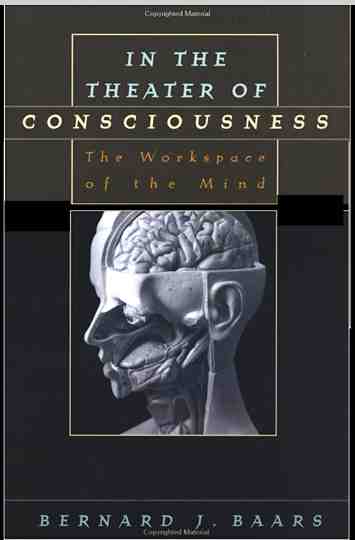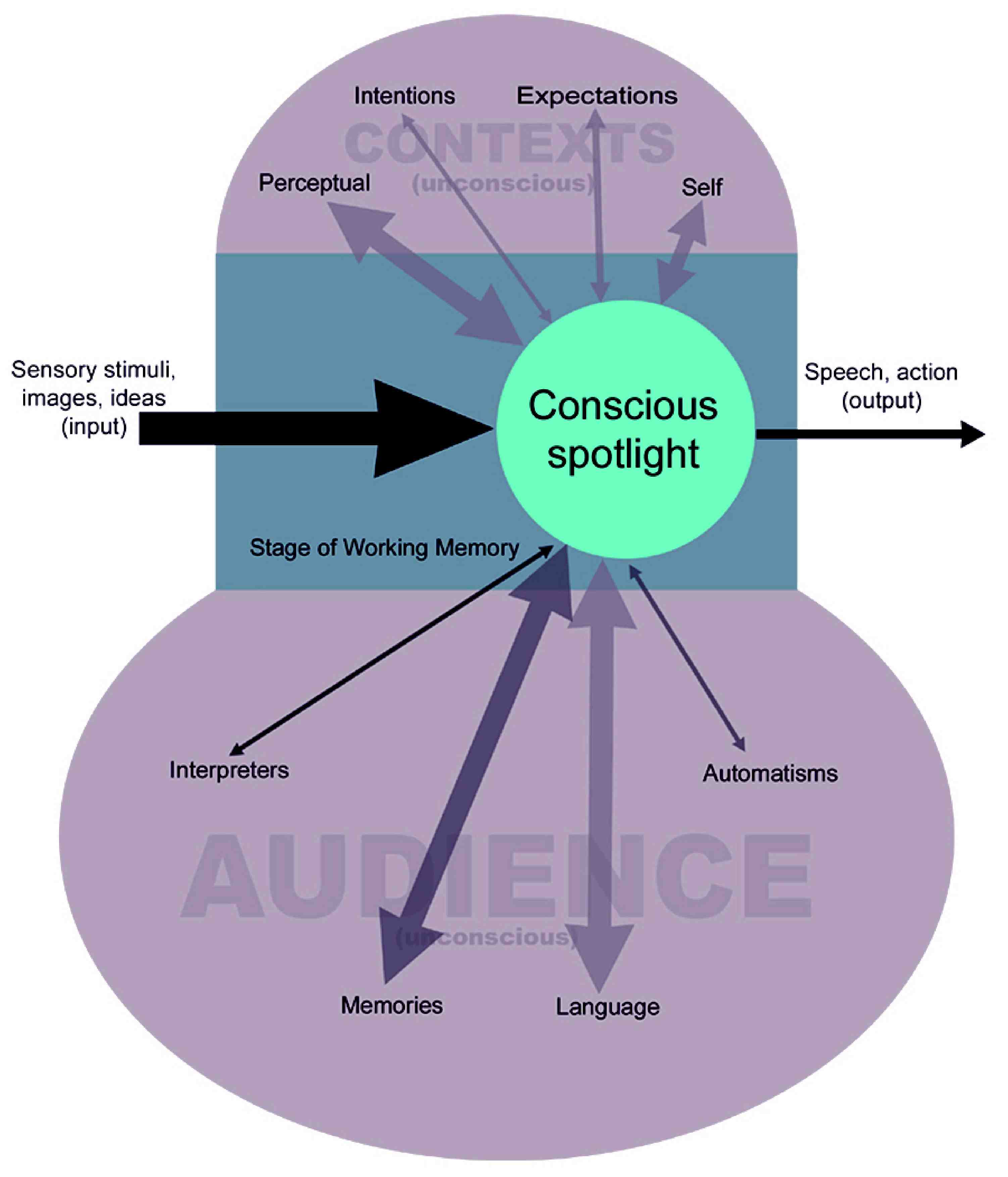Bernard Baars's Global Workspace Theory (GWT) has been around in its current (and still evolving) form since the 1990s (originally proposed in 1982 in its "beta" version, although Baars attributes the model to cognitive modelling groups led by Alan Newell and Herbert A. Simon). Over the last decade, it seems to be getting a much wider acceptance, mainly because it offers an elegant and simple explanation for the emergence of human consciousness - the purpose of consciousness is to find and implement adaptations to environmental problems to ensure survival. That is the macro picture, but it's even more interesting at the micro level.
In this post, I want to introduce and explicate a little bit of the model; in part two I will discuss a paper that employs this model to understand the future evolution of consciousness. There are elements in this model and in that paper that support aspects of integral theory, as well offering a more comprehensive and detailed model of consciousness than integral theory has been willing or able to account for.
* * * * * * *
In a 2011 paper ("Biology of Consciousness" In Frontiers in Consciousness Research), Baars, Gerald Edelman, and Joseph Gally offer this brief definition of GWT:
This Global Workspace theory hypothesizes that a number of brain components constitute an integrative workspace that serves to reconcile the narrow momentary capacity of conscious contents with a widespread recruitment of unconscious brain functions, including long-term memory.
Baars uses a theater metaphor - the theater of consciousness - to explain how consciousness functions (this is the subject of his book, In the Theater of Consciousness: The Workspace of the Mind, but it's also in this 1997 paper, "In the Theatre of Consciousness: Global Workspace Theory, A Rigorous Scientific Theory of Consciousness," published in the Journal of Consciousness Studies). [The first two chapters of the book are available as a PDF.]
He suggests that the architecture of the brain can best be understood as a working theater:
In the working theatre, focal consciousness acts as a ‘bright spot’ on the stage, directed there by the selective ‘spotlight’ of attention. The bright spot is further surrounded by a ‘fringe,’ of vital but vaguely conscious events (Mangan, 1993). The entire stage of the theatre corresponds to ‘working memory’, the immediate memory system in which we talk to ourselves, visualize places and people, and plan actions.Baars notes that consciousness - in this sense we may also think of it as awareness - is largely identified with the "‘limited capacity’ aspects of the brain," those features of our brain that impose limits on what we can experience in consciousness. These "limited capacity mechanisms" include:
Information from the bright spot is globally distributed through the theatre, to two classes of complex unconscious processors: those in the darkened theatre ‘audience’ mainly receive information from the bright spot; while ‘behind the scenes’, unconscious contextual systems shape events in the bright spot.
- immediate memory
- the selectivity of attention
- our inability to do two demanding voluntary actions at the same time
However, as Baars notes (and Kahneman discusses as Type 1 thinking), the brain is much more efficient in its "unconscious" functioning.
It seems to be a massive collection of neural nets, layers and connections, each specialized in some specific task analysing visual shapes, maintaining body temperature, or mapping body space. The great bulk of these specialized nets operate all at once, in parallel with each other, as one great society. Their joint capacity is enormous. They are mostly unconscious, and very effective at executing routine tasks.This is the part of the brain that makes many more of our decisions than we are aware of, which is why so many neuroscientists deny free will - they argue that much of our brain function is unconscious and our sense of free will is a comforting illusion. This prompts the big question from Baars:
The big puzzle is, why is the conscious aspect so limited, and the unconscious part so vast? What is the meaning of this odd conjunction?Baars identifies some of the limits of our consciousness, as well as the larger systems of the unconscious mind (important note from Baars: "What is rarely remarked, however, is that we
can create access to any part of the brain using consciousness"):
The narrow limits of conscious capacity
1. Working memory
2. Selectivity: consciousness is limited to only one dense stream of input
A vast collection of unconscious processes: the brain
1. The mental lexicon, meaning and grammar
2. Autobiographical memory
As noted above we can control many (most?) of these unconscious processes. Centuries of meditation practice and research has offered mostly anecdotal evidence (until the last two decades or so) that this is possible. Baars agrees:
Consciousness is a gateway to vast domains of knowledge and control In sum, it seems that consciousness gives us vast access to billions of neurons in the brain and body, to the mental lexicon, and to an inestimably large source of autobiographical memories. Mere unaided consciousness may be sufficient to create rapid learning and accurate recognition. Consciousness is also needed to trigger a great number of automatic routines that make up specific actions. All these effects of consciousness are unconscious. Consciousness may be considered as the gateway to these unconscious sources of knowledge.One of the final pieces of this model is how it explains or accounts for subjectivity, the awareness that we are aware. He deals with this, at least in part, in "Understanding Subjectivity: Global Workspace Theory and the Resurrection of the Observing Self" (Journal of Consciousness Studies, 1996).
He recalls that Oxford philosopher Gilbert Ryle (in The Concept of Mind, 1949) rejected the idea of "the self as observer" - often known as the observer self, the aware ego, or the Self - and for decades afterward neuroscience discounted the whole idea of a self as the ghost in the machine.
Baars rejects this position, however:
The only trouble with Ryle's impossibility proof is that some notion of self is indispensable and not noticeably problematic in daily life, and indeed in much contemporary psychology and brain science. Ryle's impossibility proof applies only if the concept of self is not decomposed into cognitive or brain entities that are better understood than the word 'self'.
And . . .
Consider William James' 'self as observer'. It is hard to see anything impossible about it if we think of observers as pattern recognizers. Many brain systems 'observe' the output of another, and we now know a great deal about pattern recognizers in the brain. There seems to be plentiful brain and psychological evidence regarding self-systems.
All that is not to deny the existence of genuine mysteries about self. But there seem to be aspects of self that are not beyond human understanding. If they were, we would have an awfully difficult time dealing with ourselves or other people. As we understand more of the details of the cortical self system, Rylean doubts may begin to sound more and more dated.
Oddly enough, in the sensorimotor area on top of the cortex there are four maps of a little upside-down person, distorted in shape, with every bit of skin and muscle represented in detail. This upside-down map is called the sensorimotor homunculus, the little human. The nervous system abounds in such maps, some of which appear to serve as 'self systems', organizing and integrating vast amounts of local bits of information. The anatomy of the brain looks like a physical refutation of Ryle's position.
After laying out a little history of the idea of subjectivity ("'subjectivity' originated in the concept of being a subject, including being the subject of a reigning king"), which eventually came to mean having a sense of self.
One of the things that I find attractive about this model is that it accounts for our multiplicity - it incorporates a variety of inherent self-models, which also allows for unique parts to arise as a product of experience. Remember back to the top, consciousness exists to help develop novel adaptive responses to our life conditions (this also supports Clare Graves's model of new developmental stages arising to cope with more complex life conditions). Here is what Baars offers about multiplicity:
For example, there seems to be a close connection between the sense of subjectivity and what Michael Gazzaniga has called the 'left-brain interpreter', the part of the brain that maintains a running commentary about our experience. In split-brain patients, where transfer of information between the two hemispheres is blocked, the left side can be shown to maintain a narrative account of its reality that can be quite different from the right side's story. But the left-hemisphere system is clearly not the only 'self-system' in the brain. There is good evidence for a sensorimotor self, an emotional and motivational self probably represented in the right hemisphere, a social self-system, and perhaps an appetitive self. All these self-systems ordinarily work in reasonable coordination with each other, though they can be in conflict at times. (Baars, 1996)Finally, over the last decade he has been working with other theorists, including Gerald Edelman (Dynamic Core theory, proposing that a dynamic core is "generated by a neural process, reentry, to link dispersed cortical and thalamic areas and account for the relation between perception and conscious memory"), and Stan Franklin's LIDA model (Learning IDA, where IDA is an Intelligent Distribution Agent). According to Wikipedia, LIDA offers an integrated model of cognitive function:
Comprising a broad array of cognitive modules and processes, the LIDA architecture attempts to implement and flesh out a number of psychological and neuropsychological theories including Global Workspace Theory,[12] Situated Cognition,[13] perceptual symbol systems,[14] Working Memory,[15] memory by affordances,[16] long-term working memory,[17] and the H-CogAff architecture.[18]Global Workspace may be the closest thing I have seen to an integral model of consciousness in that it incorporates brain structures in detail, and accounts for the interaction of brain/mind and environment to shape the self-system. Furthermore, it accounts for subjectivity as more than a by-product of brain function, allows for multiplicity of self-systems, and incorporates the reality of self-awareness (meditation, mindfulness, introspection) to shape and expand our sense of consciousness - all of which contribute to evolutionary mechanisms for increasing levels of consciousness.
In part two, I will discuss a paper that proposes a model for consciousness evolution.


No comments:
Post a Comment